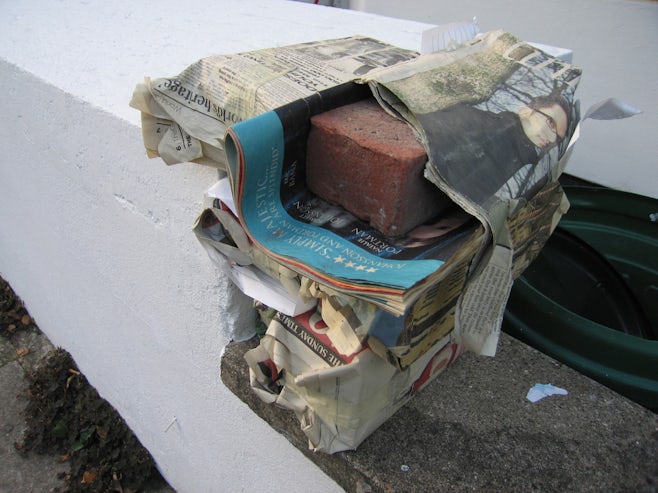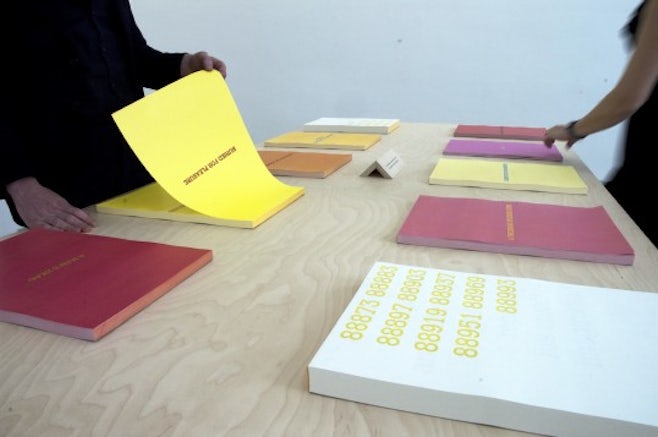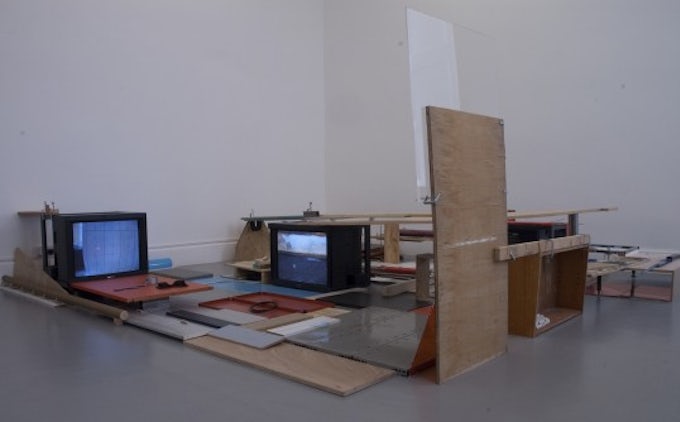
Anne Tallentire’s practice engages a range of media and forms including installation, performance and moving image. Tallentire was born and raised in Co. Armagh in the north of Ireland, and has lived and worked in London since 1984. Tallentire is now a professor and tutor at Central Saint Martins College of Art and Design, as well as a convenor of the research project Double agents, which seeks to incite performative dialogues between interdisciplinary and international artists.

Central to Tallentire’s investigation is how institutional, political and social systems might produce a peripatetic practice. Her practice often forms itself on the street, from filming workers in the city of London to locating materials that are used in installations. The ensuing investigations are made both individually and in collaboration with others in the gallery space, notably with John Seth, under the banner of long term collaborative practice work-seth/tallentire. Committed to the overlooked and the mundane, this could be articulated by Georges Perec’s question: How are we to speak of common things?01
In the conversation below, writer and curator Lisa Panting speaks to Tallentire shortly after a screening of the latter’s work at Picture This, Bristol and before a professorial platform event at the Cochrane Theatre, London.
Making Present Thought
LISA PANTING: When I think about your practice, I initially think about a sense of movement, deftness and a lightness with which you approach your subject. This performative modus operandi seems to act as the connective tissue between process and content. Can you say something about that?
ANNE TALLENTIRE: This might have something to do with itinerancy. I am interested in flux, mobility, chance and working with a dismantling, re-figuring and re-ordering of materials and systems, primarily in relation to conditions of social and political life. This then produces a practice that is more or less permanently on the move, materially and conceptually.
LP: In your solo show ‘This and Other Things 1999–2010’ at the Irish Museum of Modern Art (IMMA) in 2010, you showed more recent projects, such as the new installation Nowhere Else(2010), a digitally interactive double-screen video projection that invites you to click on points produced by overlaying the map of London on a chart of constellations. This work brings together several of your concerns: mapping, the happenstance of ‘finding’ readymade images and duration as well performativity.
AT: You used the word performativity there, were you thinking about the performativity of the spectator or the work performing itself?
LP: An element of both actually, the work performing itself and the invitation to participate, so I mean you on the street in the first instance. Three kinds of performativity come together – the installation does not entail your performance like earlier works might have done, rather the mechanisms of the work take over that role.
AT: Before I talk about Nowhere Else, I’ll just say a little about Inscribe (1993–94), as this work partially foregrounds Nowhere Else. Inscribe consists of various elements, including the transmission of pre-recorded video footage, live action to camera and conversations between audiences, transmitted to audiences simultaneously in Dublin, London and Derry. The actions were mundane – for example, emptying and lining up a box of old pen nibs, reading a passage from a book on managing institutions (i.e. working with things to hand), and for the first time improvising actions on the street and in the studio.
LP: So you had already thought of how you could use technologies. What works so well with Nowhere Else is that you are not confronted with a demand to ‘interact’. It operates more as an implication; it’s more subtle.
AT: I struggle with the term ‘interaction’, yet frequently involve the viewer to explore ideas relating to participation and autonomy. Nowhere Else originally came about because I was commissioned by the [UK] Government Art Collection, to make a work for the Ministry of Justice building. I proposed to make an interactive DVD to be given to everyone who worked there – a private form of public art, if you like – but the plug was pulled on that. So when I got the opportunity to show at IMMA, I decided to develop a version of the work for a gallery situation where viewers would be able to navigate their way through the work at will. This links back to Inscribe, where the work only became fully operational when the audiences spoke to one another.
LP: So perhaps we could call it navigation instead of interaction? The spectator is invited to navigate a set of parameters, a series of propositions you have put in place to enable an exchange, between the work as it produces itself and the viewer. In Nowhere Else, can I ask you about the image of the constellation – was it something you had looked at before?
AT: Years ago, when asked to make work for a gallery space (at L’École des Beaux-Arts, Paris) that had a spectacular glass roof and walls decorated with images of the night sky, my first thought was to bring those stars down to earth. That meant in material terms projecting a mirror image of the sky on the floor below. It was an unworkable proposition but perhaps the starting point for Nowhere Else, which began with wanting to suggest imaginary lines running between the stars above and where we stand below. There are now phone applications that do this brilliantly, of course, but the schema for this work was about identifying how the political is made manifest in the mundane. Through various cartographies of place, be it in a random taxonomy of place names or absurd patterns of remnants of daily life, revealing what might be at stake in navigating cultural, historical and mythological space.
LP: You’re really invested in critical theory and philosophical thinking. I am thinking about how you read The Practice of Everyday Life (1984) by Michel de Certeau at a certain moment for you. Can you highlight those thinkers or bodies of work especially important to you?
AT: De Certeau’s analysis of city living was invaluable in relation to Inscribe and Trailer (1998), made in collaboration with John Seth, as was Hannah Arendt’s account of work, labour and action. Recently I have been reading Short Voyages to the Land of the People (2003) by Jacques Rancière, which examines forms of displacement through tales of travel and reflections on what it means to be foreign. Agamben’s What Is an Apparatus was key when working on Drift (2002–10) and [Michael Hardt and] Antonio Negri’s evocations on empire and multitude have been significant. And of course, French feminist theories on difference and post-structuralist theory influenced me in the 1980s; also, I return frequently to Foucault’s critique of power and social relations.

LP: Your collaboration with John Seth is pivotal; you were particularly active over a ten-year period together. Projects such as Trailer, Manifesto (2001-2004) and Dispersal (2000) make manifest in objects a political articulation that is inferred through your aesthetic choices. Are these installations a reproduction of the action of finding, thinking and locating objects that you already carried out on the streets – or is it the studio/gallery process of transformation in addition to an initial process that seems to carry such meaning for you?
AT: My very early work dealt more overtly with the specific historical and social constructs of place and more directly addressed issues related to Ireland. Manifesto, Dispersal and Trailer – the latter a key piece that is now coming back into view – are all works I have made with John [Seth] as part of our collaboration work-seth/tallentire. In terms of an improvisational working method and an engagement with the city these works all engage processes of working that involve gathering and working with found objects on the street as one core method of practice. These works also allude to cultural difference, territory and borders; concerns that each of us have brought to the collaborative practice over many years, a practice that we think of as a form of storehouse: a place within and from which work evolves through a dynamic practical and discursive process that operates between improvisation and consensus. This could be said to represent an attempt to address the collective imperative – whether that be in relation to another person, institution or site.
LP: Nevertheless, there is a shift between the works you make by yourself and the works you make in collaboration. For one thing, you seem to operate within a different space, and collaboration is a bringing together, a making of work that is more ‘consensual’. There is something in that work that you have carried forward into Nowhere Else and also Photositings, a series of photographs of piles of stuff left on the pavement whilst walking through London that looks at the decisions people make whilst stacking and storing (2007–ongoing) – perhaps the element of negotiation that is now not so regularly with Seth, but rather with objects and the specificity of place.02
AT: In both of these works I was opening up the terms of reference, using photography as a means to construct a visual syntax of the seemingly incidental. Here I set about investigating an overlooked performance of the material world. The frame is used here as a speculative device or tool, in terms of an investigation of limits. And both works have a potential to continue infinitely, as they are constructed as boundless inventories.
LP: Can we talk about the move from staging your own actions to those of others? The migration from making performance, to identifying the performative in the fabric of the city and institutional life?
AT: While making Dispersal for Void (in Derry, 2002) I began to consider giving up live performance. Dispersal engaged a complex structure in three parts. In part one, a cinematographer from Derry, according to a set of instructions, gathered images and objects from various sites throughout the city. In part two, we worked with these materials in an open view situation in the gallery over a two-week period and part three consisted of the residue of these activities being left as an installation. It was then that I began to imagine withdrawing from live performance and to think of gestures as an embodiment of the struggle, in relation to the figure of the worker. These ideas were investigated in Drift and then, more obliquely, taken further in Pursuit of Happiness (2006) and The Readers (2010)03where I gathered a taxonomy of reading materials of the employees in a library and a major cultural institution.
LP: Where are you now in your work?
AT: Field Study 1 (2010) is the first of a new series that also makes use of naming and translation in inventories. The first of this series was commissioned for ‘Gracelands’ in Sligo, curated by Vaari Claffey, and is now in the exhibition ‘Physical World’ at Le Galerie, Noisy le Sec in Paris. This work records, through exhaustively listing the names of flowers, a search for an ‘alien’ plant. This will be followed by similar surveys of various locations where plants seed themselves in unlikely places. It marks a return to a process of working that I have used for many years, not least in The Readers. At the moment, I am wary of picking up a camera of any kind. I want to move away from the photographic image for a while. I think I exhausted myself making Nowhere Else!

LP: This feeds back into working collaboratively; you never feel like you are working on your own. There is this idea of community that pervades everything.
AT: Yes, this and The Readers try to articulate an interconnectedness and interdependence that is necessary to collective enterprise. Everything we do is constituted connectively. Perhaps my interest in this connects to growing up in, or being exposed at an early age, to a society where there was always conflict. This was a work that attempted to playfully acknowledge reliance on others, the structure of a society – in this case the micro-society of the institution and the value of labour.
LP: You have been making work and dealing with this area intensely for 20-odd years. The end of the 1990s saw relational aesthetics and the notion of community that the ‘younger’ generation were continually staging. There are obvious differences to me in terms of how notions of community are perceived and represented now, and in the language that is being used and adopted by emerging artists, often just out of art school – the kind of connectivity that you talk about is often absent. Do you feel there is a more democratic notion running through art? Are younger artists more politicised? Do you feel the reverse?
AT: I think perhaps fewer readily identify themselves as having a political agenda, and that politics holds a very different meaning for the majority of this generation. The situation today nationally and globally may be about to change radically and there are many young artists working today whose work is informed politically, but the terms of engagement are different, the challenges perhaps more pressing and the context more complex.
Work from the 70s is being revisited and early activist work is becoming a significant source of reference but perhaps one of the most pressing challenges is the speed and excess of communication technology – the image is present in everything. Many art courses are providing a curriculum that is awake to these challenges – in theory at least. There is work that is based upon sophisticated and cogent critique, but resources are a worry. Not least that increasingly the majority of students in higher education will come from privileged backgrounds and this needs to be challenged through a provision that is affordable, meaningful for and relevant to a diverse society. I remember the Film and Video Department at [Central] Saint Martins in the late 1980s and 90s, actively going into schools in the wider city, to look for students who would never have had the opportunity to study at higher level otherwise. Art education may feel like it is fighting for survival but it can get its act together, engage students in planning the future and return the artist/teacher to the heart of the enterprise.
Footnotes
-
George Perec, Approaches to what? in L’Infra-Ordinaire, 1974. Species of Spaces and Other Pieces, ed. and transl. by John Sturrock, London: Penguin, 1997.
-
Since 2005 both artists have been engaged primarily in individual projects.
-
Tallentire gathered the titles of books that were being read by museum staff during her IMMA show.
